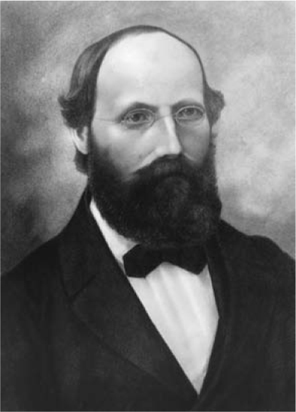
b. Breselenz, near Dannenberg, Germany, 1826;
d. Selasca, Italy, 1866
Real and complex analysis; differential equations;
differential geometry heat distribution; number theory;
propagation of shock waves; topology
Riemann was born into a poor pastor’s family and studied mathematics at Göttingen, eventually becoming a professor there. His health broke in 1862 and he died near Lake Maggiore, Italy, of pleurisy at the age of thirty-nine.
No mathematician is more associated with the mid-nineteenth-century transition from algorithmic to conceptual thought than Riemann. His doctoral thesis of 1851, and still more his paper on Abelian functions (1857), promoted the view that a HOLOMORPHIC FUNCTION [I.3 §5.6] is properly defined by the CAUCHYRIEMANN EQUATIONS [I.3 §5.6] and is to be studied through a close connection with the theory of HARMONIC FUNCTIONS [IV.24 § 5.1]. In his thesis he sketched a proof of the remarkable RIEMANN MAPPING THEOREM [V.34]. This states that if X and Y are any two simply connected open subsets in the complex plane, neither of which is the whole plane, then there is a holomorphic map from one to the other with a holomorphic inverse. For example, if you draw any closed curve in the plane that does not intersect itself, and let D be the region inside the curve, then D is biholomorphically equivalent to the open unit disk. In the 1857 paper he defined RIEMANN SURFACES [III.79], showed how to analyze them topologically, and outlined the Riemann inequality which his student Gustav Roch improved to the RIEMANN-ROCH THEOREM [V.31] in 1864. (The Riemann-Roch theorem, which is of great importance in algebraic geometry as well as complex analysis, determines the dimension of the space of meromorphic functions on a given Riemann surface with a prescribed number of poles.) In 1857 he extended the theory of differential equations, specifically the important case of the hypergeometric equation, to complex functions. In 1859 he used deep, new ideas from complex function theory to study the (Riemann) zeta function and proposed his celebrated conjecture, the RIEMANN HYPOTHESIS [IV.2 §3], concerning the location of the complex zeros of this function. The conjecture remains unsolved to this day.
Georg Friedrich Bernhard Riemann
These ideas enabled mathematicians to study complex functions on domains other than the plane and subsets of the plane. They opened the way to a geometric study of algebraic functions and algebraic curves, and proved to be decisive in the study of the integrals of algebraic functions (the theories of Abelian functions and theta functions of several variables). Investigations of the Riemann zeta function led not only to the discovery of new properties of classes of complex functions, but more recently to the use of zeta functions of many other kinds in other branches of mathematics, including dynamics.
In 1854 Riemann, inspired by his mentor DIRICHLET [VI.36], formulated the concept of the RIEMANN INTEGRAL [I.3 §5.5], which permitted him to do profound work on the convergence of trigonometric series. Dirichlet had been able to prove that a real function was correctly represented by a Fourier series, but only under very restrictive conditions. This left open the questions of what sorts of functions did not satisfy these conditions and how could they be studied. Riemann reformulated the concept of the integral and was able to show that it is not just the continuity of a function and the ways in which it may fail to be continuous that affect the accuracy of its Fourier series representation, but the nature of its oscillations. The Riemann integral remained the dominant definition of the integral until it was replaced by the LEBESGUE INTEGRAL [III.55] after 1902, which is better adapted to capturing the way the behavior of a function affects its Fourier series.
In a lecture, also given in 1854 (but published posthumously in 1868), he entirely reformulated geometry as being about spaces (sets of points, which he called MANIFOLDS [I.3 §6.9]) with a RIEMANNIAN METRIC [I.3 §6.10] (an appropriate concept of distance) and argued that the geometric properties of a space were its intrinsic ones. He noted that there are three constant-curvature spaces in two dimensions and showed how the idea of constant curvature can be extended to higher dimensions. In passing, he was the first person to write down a metric for non-Euclidean geometry (more than a decade before Beltrami’s publication of 1868, which legitimized non-Euclidean geometry). This lecture earned him the right to teach in a German university.
Riemann also did important work on shock waves, and shares with WEIERSTRASS [VI.44] the honor of introducing the methods of complex function theory in the study of MINIMAL SURFACES [III.94 §3.1], where he was led to several new solutions of the Plateau problem, which asks for the surface of least area spanning a given curve in space.
The distinguished complex analyst Lars Ahlfors once described Riemann’s complex analysis as consisting of “almost cryptic messages to the future” and said that his mapping theorem was given in a form that “would defy any attempt at proof, even with modern methods,” and it is true that Riemann’s presentation is more visionary than precise. But his vision described a geometric setting for complex function theory that, as Ahlfors’s own work indicates, remains fertile over 150 years after it was written.
Laugwitz, D. 1999. Bernhard Riemann, 1826-1866. Turning Points in the Conception of Mathematics, translated by A. Shenitzer. Boston, MA/Basel: Birkhäuser.
Riemann, G. F. B. 1990. Gesammelte Werke, Collected Works, edited by R. Narasimhan, third edn. Berlin: Springer.